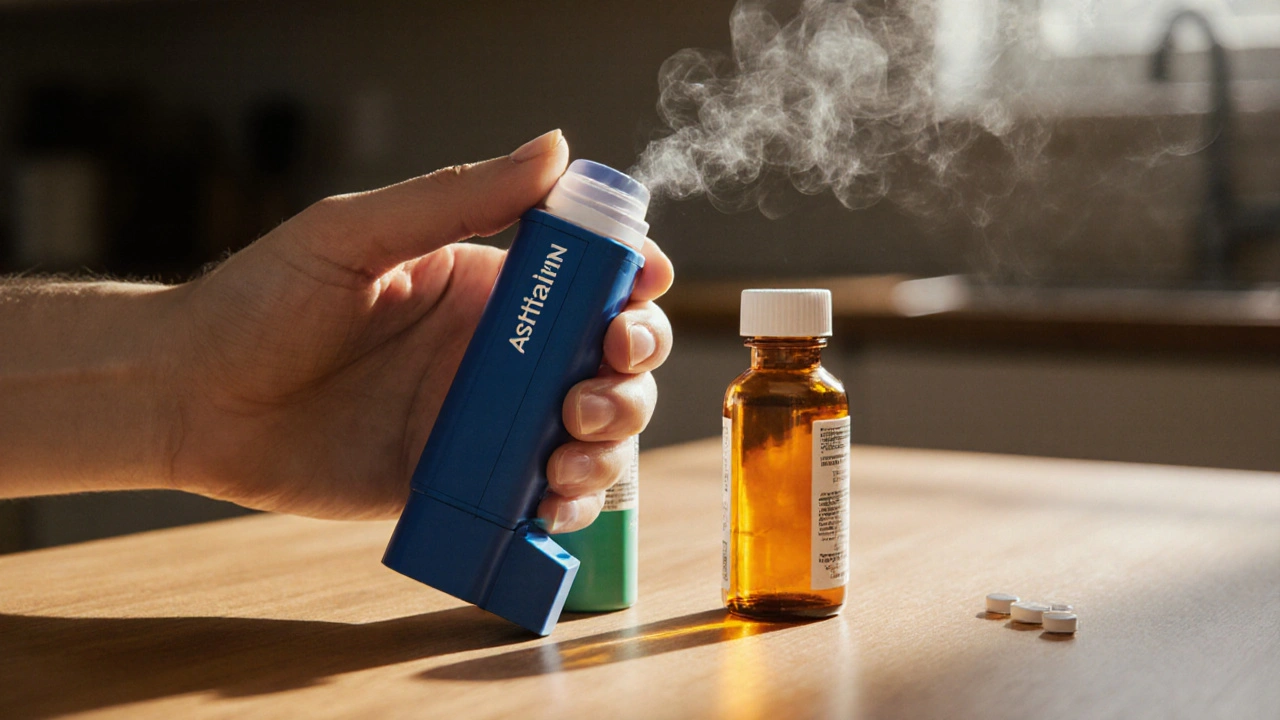Asthalin (Salbutamol) vs. Top Asthma Medication Alternatives - A Comparison Guide

Asthma Medication Comparison Tool
Select Medications to Compare
When an asthma attack hits, the first thing you reach for is often an inhaler. Asthalin is a brand name for salbutamol, a short‑acting β2‑agonist inhaler used to relieve acute asthma symptoms. But what if Asthalin isn’t available, feels too strong, or you simply want to explore other options? This guide breaks down the most common alternatives, compares how they work, and helps you decide which one fits your lifestyle and health needs.
TL;DR
- Asthalin (salbutamol) works fast (2‑5min) but lasts only 4‑6hours.
- Levalbuterol offers similar relief with fewer tremors.
- Ipratropium is useful for combined COPD‑asthma patients.
- Long‑acting agents like salmeterol or formoterol are for maintenance, not rescue.
- Non‑beta‑agonist options (theophylline, montelukast) target inflammation or smooth‑muscle tone rather than immediate bronchodilation.
How Asthalin (Salbutamol) Works
Salbutamol binds to β2‑adrenergic receptors on airway smooth muscle, triggering a cascade that relaxes the muscle and opens the airways. The result is rapid symptom relief, making it the go‑to rescue inhaler for most asthma action plans. Typical doses are 100‑200µg per puff, with up to 4‑8 puffs per day recommended.
Key Alternatives at a Glance
Below are the most widely prescribed alternatives, each with its own mechanism and ideal use case.
- Albuterol (brand names Ventolin, ProAir) - another short‑acting β2‑agonist, virtually identical to salbutamol in effect.
- Levalbuterol (Xopenex) - the R‑enantiomer of albuterol, offering similar bronchodilation with less cardiac stimulation.
- Ipratropium bromide (Atrovent) - a muscarinic antagonist that blocks bronchoconstriction, often combined with a β‑agonist.
- Theophylline - an oral methylxanthine that relaxes airway smooth muscle and reduces inflammation.
- Montelukast - a leukotriene‑receptor antagonist taken daily to prevent exercise‑induced and allergen‑triggered asthma.
- Salmeterol - a long‑acting β2‑agonist (LABA) used twice daily for maintenance.
- Formoterol - another LABA with a faster onset, suitable for both maintenance and, in some regions, as a rescue when combined with inhaled steroids.

Side‑by‑Side Comparison
| Medication | Class | Onset | Duration | Typical Form | Primary Use | Common Side Effects |
|---|---|---|---|---|---|---|
| Asthalin (Salbutamol) | Short‑acting β2‑agonist (SABA) | 2‑5min | 4‑6h | Metered‑dose inhaler, nebulizer | Rescue relief | Tremor, tachycardia, headache |
| Albuterol | SABA | 2‑5min | 4‑6h | MDI, DPI, nebulizer | Rescue relief | Similar to salbutamol |
| Levalbuterol | SABA (R‑enantiomer) | 2‑5min | 4‑6h | MDI, nebulizer | Rescue relief with milder cardiac effects | Reduced tremor, mild nausea |
| Ipratropium | Anticholinergic | 5‑15min | 6‑8h | MDI, nebulizer | Adjunct for COPD‑asthma overlap | Dry mouth, cough |
| Theophylline | Methylxanthine | 30‑60min | 8‑12h | Oral tablets, SR capsules | Long‑term control | Nausea, arrhythmia at high levels |
| Montelukast | Leukotriene‑receptor antagonist | ~2h | 24h | Oral chewable tablet | Prevention of exercise‑induced asthma | Headache, abdominal pain |
| Salmeterol | Long‑acting β2‑agonist (LABA) | 15‑30min | 12h | MDI | Maintenance therapy (never alone) | Thrill, potential paradoxical bronchospasm |
| Formoterol | LABA | 1‑3min | 12h | MDI, DPI | Maintenance; some regions allow rescue w/ steroid combo | Similar to salmeterol, faster onset |
Pros and Cons of Each Option
Asthalin (Salbutamol) - Pros: lightning‑fast relief, inexpensive, widely available. Cons: short duration, can cause jittery feelings, tolerance builds with overuse.
Levalbuterol - Pros: same speed, less tremor, better for patients with heart‑rate sensitivity. Cons: higher cost, limited availability in some provinces.
Ipratropium - Pros: works on a different pathway, useful when β‑agonists alone aren’t enough, safe for patients on β‑blockers. Cons: slower onset, dry mouth, doesn’t replace a SABA for rescue.
Theophylline - Pros: oral dosing, long half‑life, inexpensive generic. Cons: narrow therapeutic window, requires blood‑level monitoring, many drug interactions.
Montelukast - Pros: once‑daily pill, helps with allergic triggers, good for children who dislike inhalers. Cons: not a rescue med, possible neuropsychiatric side effects (rare).
Salmeterol & Formoterol - Pros: provide 12‑hour control, reduce need for frequent SABAs. Cons: must be paired with inhaled steroids, risk of severe asthma attacks if used alone.
Choosing the Right Medication for You
Think of your asthma management as a three‑layer cake: quick rescue, daily control, and trigger prevention. Asthalin fits the rescue layer. If you need a backup for “rescue‑only” days, consider Levalbuterol for a smoother ride. For patients who also have chronic obstructive pulmonary disease (COPD) features, adding Ipratropium can smooth out the breathing curve.
When you’re looking to cut down on inhaler use, long‑acting agents (Salmeterol, Formoterol) plus an inhaled corticosteroid become the base layer. If oral medication is more convenient, Theophylline or Montelukast may fill the gap, but remember they don’t replace fast‑acting inhalers.
Cost is another deciding factor. In Canada, generic salbutamol inhalers hover around CAD15‑20 for a 200‑dose pack, while branded Levalbuterol can exceed CAD60. Public drug plans often cover the SABA but may require prior authorization for LABAs or leukotriene antagonists.
Safety Tips & Common Pitfalls
- Never exceed the prescribed number of puffs per 24hours; overuse can mask worsening inflammation.
- If you find yourself needing a rescue inhaler more than twice a week, it’s time to revisit your maintenance therapy.
- Watch for drug interactions: Theophylline interacts with antibiotics like erythromycin and anti‑arrhythmics.
- Pregnant patients should discuss any change, especially with oral agents, as placental transfer varies.
- Store inhalers at room temperature, away from direct sunlight, and replace them after the expiration date - potency drops.

Frequently Asked Questions
Is Asthalin the same as Albuterol?
Yes. Asthalin is the brand name for salbutamol, which is the same molecule marketed as albuterol in the United States. Effectiveness, dosage, and side‑effects are virtually identical.
When should I switch from Salbutamol to Levalbuterol?
Consider Levalbuterol if you experience frequent tremors, palpitations, or anxiety after using Salbutamol. It offers the same bronchodilation with fewer cardiovascular side effects, though it’s pricier.
Can I use Ipratropium instead of a SABA during an attack?
Ipratropium works slower and is less potent for acute relief, so it should be used alongside a SABA, not in place of one. It’s most helpful for patients with both asthma and COPD.
Is Montelukast a rescue inhaler?
No. Montelukast is a preventive, once‑daily pill that blocks leukotriene inflammation. It won’t open your airways during a sudden flare‑up.
What should I do if my rescue inhaler isn’t working?
If you’ve taken two doses (usually 200µg total) and symptoms persist, seek emergency care immediately. This may signal a severe asthma attack that requires systemic steroids or nebulized treatment.
Gareth Pugh
September 29, 2025 AT 15:08Salbutamol’s lightning kick is a classic rescue, but the jitter that tags along can feel like a coffee overload.
anshu vijaywergiya
October 7, 2025 AT 03:41When the airway tightens like a vice, the swift surge of Asthalin feels like a heroic trumpet blasting through a storm‑filled canyon. Its rapid onset is the golden thread that pulls you back from the edge, granting precious seconds to steady your breath. Yet, the tremor that follows can betray the calm you so desperately seek, turning your hands into a nervous drum. The paradox of power and side‑effects is a dance of chemistry, a reminder that even lifesavers have a price. Remember, every puff is a pact with the molecule that promises freedom, but demands respect.
ADam Hargrave
October 14, 2025 AT 16:15Oh great, another “miracle” inhaler that makes your heart race faster than your Wi‑Fi on a good day. 😂
Michael Daun
October 22, 2025 AT 04:48salbutamol works fast but i dun mind the shakes u get after a few puffs
Rohit Poroli
October 29, 2025 AT 16:21From a pharmacodynamic perspective, the β2‑adrenergic agonist profile of salbutamol facilitates intracellular cyclic AMP accumulation, culminating in smooth muscle relaxation via protein kinase A activation; clinically, this translates to bronchodilation within 2‑5 minutes, optimizing peak flow metrics in acute exacerbations.
William Goodwin
November 6, 2025 AT 04:55Imagine standing at the brink of a precipice, lungs screaming for air, and then-
wham!-a mist of Asthalin floods the airways like a sunrise over a foggy sea. 🌅 The sensation is nothing short of cinematic, the kind you’d expect in a blockbuster where the hero grabs the inhaler just in time. Each puff feels like a plot twist that flips the narrative from panic to poise. Yet, the story isn’t without its antagonists; tremors and a racing pulse often appear as uneasy side characters, reminding us that every rescue has its cost. Still, the script repeats itself for a reason: the reliability of that 2‑minute onset is the hallmark of a trusted ally in the asthma saga.
Isha Bansal
November 13, 2025 AT 17:28While the pharmacological efficacy of salbutamol is incontrovertibly well‑documented, one must also consider the broader therapeutic context in which this agent operates. The molecule’s rapid onset of action, typically within two to five minutes, undeniably renders it a cornerstone of acute asthma management protocols. Nonetheless, the brevity of its bronchodilatory effect, lasting merely four to six hours, imposes a finite window of symptomatic relief that necessitates vigilant monitoring. It is incumbent upon clinicians to educate patients regarding the appropriate frequency of usage, lest the temptation to exceed recommended dosages precipitate tachyphylaxis. Moreover, the adverse effect profile, comprising tremor, tachycardia, and occasional headache, may be tolerable for many but can be prohibitive for individuals with pre‑existing cardiovascular sensitivities. The discourse surrounding the choice between salbutamol and its enantiomeric counterpart, levalbuterol, often hinges upon comparative studies that suggest a modest reduction in cardiac stimulation with the latter, albeit at a higher economic cost. In regions where healthcare expenditure is a paramount concern, cost‑effectiveness analyses frequently favor the generic salbutamol formulation. Additionally, the therapeutic landscape includes adjunctive agents such as ipratropium, which, when combined with a SABA, can augment bronchodilation via a distinct anticholinergic mechanism. Theophylline, although relegated to a secondary role due to its narrow therapeutic index, remains a viable oral option for select patient cohorts. Likewise, leukotriene modulators like montelukast serve a preventative function, yet they are unequivocally unsuited for acute rescue. It is imperative to delineate the roles of short‑acting versus long‑acting β2‑agonists, ensuring that LABAs are never prescribed as monotherapy. The longitudinal data on LABA safety underscore the necessity of concurrent inhaled corticosteroid therapy to mitigate the risk of severe exacerbations. Finally, patient adherence, inhaler technique, and environmental trigger avoidance collectively influence outcomes to a degree that rivals pharmacologic intervention alone. In summation, while salbutamol retains its status as the quintessential rescue inhaler, an individualized approach that integrates comorbid conditions, socioeconomic factors, and patient preferences yields the most optimal disease control.
Ken Elelegwu
November 21, 2025 AT 06:01One might argue that such an exhaustive treatise, though erudite, risks obfuscating the pragmatic simplicity that clinicians seek when prescribing rescue therapy.
Gene Nilsson
November 28, 2025 AT 18:35In conclusion, the efficency of salbutamol, though widely acknowledged, demends cautious adherence to dosing guidelines, lest inadvertant overuse precipitate iatrogenic complications.
Vintage Ireland
December 6, 2025 AT 07:08Life’s breath is a series of pauses and pushes; an inhaler is just the lever that helps us snag a few more pushes when the pause feels too long.
Anshul Gupta
December 13, 2025 AT 19:41Honestly, these tables are just a marketing fluff parade; everyone knows you’ll end up buying the brand that your insurance pushes, regardless of the nuanced differences listed here.
Maryanne robinson
December 21, 2025 AT 08:15Let’s take a step back and look at the bigger picture: while the guide does present a lot of data, each medication has its niche that can genuinely improve quality of life when matched to the right patient profile. For instance, someone who suffers from exercise‑induced bronchoconstriction may find montelukast to be a game‑changer, reducing the need for multiple puffs before a run. Conversely, a patient with frequent nighttime symptoms might benefit more from a LABA combined with an inhaled steroid, offering smoother control across the 24‑hour cycle. The key is not to dismiss these options outright but to evaluate them against individual triggers, tolerability, and lifestyle. By doing so, you empower yourself to make an informed decision rather than blindly following insurance formularies. Remember, every medication is a tool, and the best tool is the one you actually use correctly.
Erika Ponce
December 28, 2025 AT 20:48In short, pick what works for you and stick with it.
Danny de Zayas
January 5, 2026 AT 09:21Just make sure you have a spacer if you use a MDI.